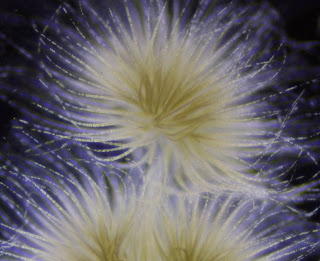Cyanobacteria’s ability to capture solar energy and fix CO2 holds promise for biotech applications
The Science
Researchers studied 10 different cyanobacteria to identify their secondary metabolites (compounds produced during normal cellular metabolism not directly involved in cell growth, that may play an important role in interactions outside the cell) and the genes linked to those molecules.
The Impact
Understanding the metabolic pathways of cyanobacteria is an essential step for using them to produce biofuels, but those pathways are not well understood. The researchers identified numerous compounds associated with cyanobacteria metabolism, more than half of which were previously unknown, and found linked genes for several of them.
Summary

Cyanobacteria produce numerous metabolic compounds, many of which have not yet been characterized or linked to specific genes.
Dark field image of cyanobacteria via flickr user Specious Reasons
The team examined 10 diverse cyanobacteria species, detecting 264 different metabolites. The researchers used a technique called tandem mass spectrometry, where a relatively large molecule of interest is isolated, smashed into smaller bits which are analyzed chemically and finally, the information gathered about the bits is used to understand the whole molecule. The cyanobacteria genes and synthesis pathways were identified using the data and tools in the DOE JGI’s Integrated Microbial Genomes database.
This study builds on a previous finding of unexpected metabolites, including histidine betaine and its derivatives, first identified in a cyanobacteria species in 2010 by first author, Richard Baran. “We wondered if it was present in other cyanobacteria and whether we could link them back to specific genes,” Baran said.
The multi-institution team, led by Trent Northen, Berkeley Lab Life Sciences Division Staff Scientist and a recent addition to the DOE JGI staff, published its results in the journal, Marine Drugs, on September 30. The project is another example of the DOE JGI’s goal to expand its capacity, in alignment with its 10-Year Vision for understanding metabolic pathways of plant, fungal and microbes.
The team found betaines in nine of the 10 cyanobacteria studied. Another surprising finding was that one of the cyanobacteria, Microcoleus vaginatus, produced a series of unusual sugar polymers. M. vaginatus lives in soil crusts, soils in arid climates held together by organic material and microorganisms. Baran and Northen speculate M. vaginatus excretes the carbohydrates to contribute to the soil crust.
Corresponding genes were identified for several of the compounds researchers studied, but they were unable to link specific genes to most of the metabolites because the pool of 10 species studied was not large enough. They suggest that scaling up an effort like this one to include more strains would not only identify many more novel metabolites, but make it possible to identify the genes that control their production. They are planning next to study how cyanobacteria metabolites contribute to the food web around them and are used by neighboring organisms.
Contact
Trent Northen
Lawrence Berkeley National Laboratory/DOE Joint Genome Institute
[email protected]
Funding
DOE Office of Science, Office of Biological and Environmental Research
Institute Pasteur
Publication
Baran R, et al, Functional Genomics of Novel Secondary Metabolites from Diverse Cyanobacteria Using Untargeted Metabolomics. Marine Drugs. 2013; 11(10):3617-3631.
doi:10.3390/md11103617